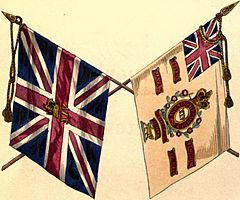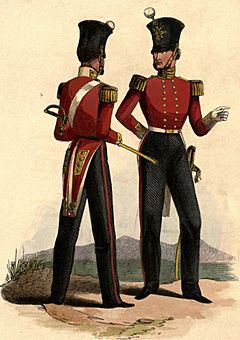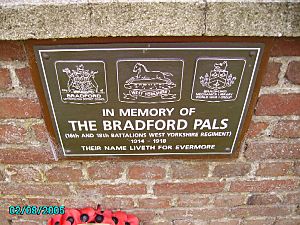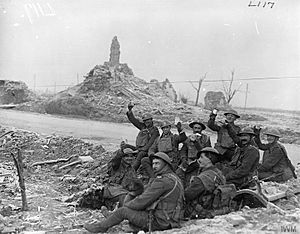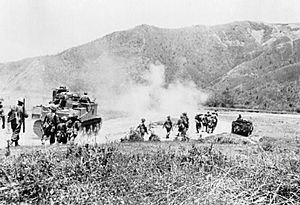West Yorkshire Regiment facts for kids
Quick facts for kids West Yorkshire Regiment |
|
|---|---|
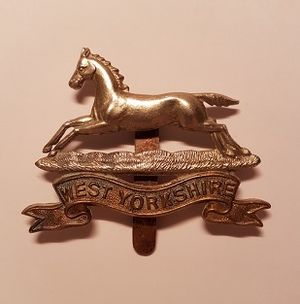
Cap badge of the regiment
|
|
| Active | 1685–1958 |
| Country | |
| Branch | |
| Type | Line Infantry |
| Size | 1–3 Regular Battalions Up to 2 Militia and Special Reserve Battalions |
| RHQ | Bradford Moor Barracks (1873–1878) Imphal Barracks, York (1878–1958) |
| Nickname(s) | Calvert's Entire, The Old and Bold |
| Motto(s) | Nec Aspera Terrent (Latin: Difficulties do not daunt) |
| March | Ça Ira |
| Anniversaries | Imphal (22 June) |
| Engagements | Namur Fontenoy Falkirk Culloden Brandywine |
The West Yorkshire Regiment (Prince of Wales's Own) was a famous infantry (foot soldiers) regiment in the British Army. It was also known as the 14th Foot. This regiment existed for a very long time, from 1685 until 1958.
In 1958, it joined with another regiment, the East Yorkshire Regiment. Together, they formed the Prince of Wales's Own Regiment of Yorkshire. Later, in 2006, this new regiment combined with two others to create the Royal Yorkshire Regiment.
Contents
- History of the Regiment
- Early Years: 1685 to 1776
- Fighting in the American War of Independence
- The French Wars: 1782 to 1815
- The Victorian Era: 1837 to 1900
- Second Boer War: 1899 to 1902
- Early 20th Century Changes
- First World War: 1914 to 1918
- Between the World Wars
- Second World War: 1939 to 1945
- After the Wars: 1948 to 1958
- Regimental Museum
- Battle Honours
- Victoria Cross Heroes
- Leaders of the Regiment
History of the Regiment
Early Years: 1685 to 1776
The regiment started in 1685. It was formed by Sir Edward Hales to help stop the Monmouth Rebellion. After a big change in government in 1688, William Beveridge became its new leader.
The regiment first went to Flanders (now Belgium) in 1693. There, it earned its first "battle honour" at the Siege of Namur in 1695. A battle honour is like a special award for bravery in a battle.
After 1697, the regiment served in Ireland. Then, in 1715, it moved to Scotland to fight in the Jacobite Rising. This was a fight to put a different king on the throne. They fought at Glen Shiel in 1719.
From 1727, the regiment spent 15 years in Gibraltar. This was during the 1727 Siege, where they defended the area.
During the War of the Austrian Succession, they fought at Fontenoy in 1745. They were then called back to Scotland to stop another rebellion. They took part in the battles of Falkirk and Culloden.
In 1751, the regiment officially became the 14th Regiment of Foot. They returned to Gibraltar for another eight years. In 1765, the King allowed their special grenadier soldiers to wear bearskin caps. These caps had the White Horse of Hanover symbol, showing the King's special favour. In 1766, the regiment sailed to North America.
Fighting in the American War of Independence
The 14th Regiment was in Boston, but they were not involved in the Boston Massacre. This event happened when soldiers from another regiment fired into a crowd.
The 14th stayed in Boston until 1772. Then, they went to St Vincent in the Caribbean. They helped stop a rebellion by Maroon people there. By 1774, many soldiers were sick or had died. The regiment was supposed to go back to England. Instead, they were sent to St. Augustine, Florida and the Bahamas.
In January 1776, parts of the 14th Regiment helped burn Norfolk, Virginia. Later that year, the remaining soldiers joined other units. New officers went back to Britain to find new recruits.
In 1777, special "rifle companies" from the 14th and 15th regiments were sent to America. These companies were trained to use rifles, which were more accurate than muskets. They fought at the battle of Brandywine on September 11. After this, these special companies became the "light companies" of their regiments.
The French Wars: 1782 to 1815
In 1782, the regiment was renamed The 14th (Bedfordshire) Regiment. When the French Revolution began, Britain sent soldiers to fight in the Low Countries. The 14th Regiment fought bravely in many battles. They earned the battle honour 'Tournay' for their actions at Tournai in 1794.
At the Battle of Famars in 1793, their leader ordered the band to play the French song “Ça Ira.” This song later became the regiment's official march. The regiment suffered many losses in a tough fight at Geldermalsen in 1795. After a difficult winter retreat, they returned to England.
From 1795 to 1803, the regiment served in the West Indies. In 1797, they took part in the peaceful invasion of Trinidad.
When the Napoleonic Wars started in 1803, the British Army grew. The 14th Regiment formed a second battalion in 1804 and a third in 1813. The 1st Battalion spent 25 years in India. During this time, they fought against the French in Mauritius in 1810 and the Dutch in Java in 1811. Java became another battle honour.
The 2nd Battalion fought in the Peninsular War in 1808-1809. They earned the battle honour Corunna. This battalion was later disbanded in 1817. The 3rd Battalion fought bravely at the famous Battle of Waterloo in 1815. It was disbanded in 1816.
The Victorian Era: 1837 to 1900
After the French Wars, the 14th Regiment served in the West Indies, Canada, and Malta. In 1855, they fought in the Crimean war.
In 1876, the Prince of Wales gave new flags (Colours) to the 1st Battalion. He also gave the regiment the special title The Prince of Wales's Own. A second battalion was formed again in 1858. This battalion fought in the New Zealand Wars and the Second Anglo-Afghan War.
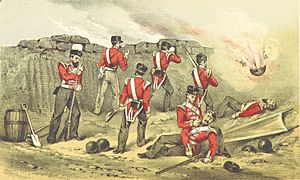
The regiment moved its main headquarters to Imphal Barracks in York in 1878. In 1881, its name changed to The Prince of Wales's Own (West Yorkshire Regiment).
Second Boer War: 1899 to 1902
In 1899, the 2nd Battalion went to South Africa for the Second Boer War. Two soldiers from the battalion, Captain Mansel-Jones and Sergeant Traynor, were awarded the Victoria Cross. This is the highest award for bravery in the British military.
Other parts of the regiment, including volunteer battalions, also sent soldiers to the war. They earned the battle honour South Africa 1900–02.
Early 20th Century Changes
In 1908, the volunteer and militia forces were reorganized. The regiment now had two Reserve battalions and four Territorial battalions. These battalions were based in places like York, Bradford, and Leeds.
First World War: 1914 to 1918
Many battalions of the West Yorkshire Regiment fought in the First World War.
Regular Army Battalions
The 1st Battalion arrived in France in September 1914. They fought on the Western Front. The 2nd Battalion also arrived in France in November 1914 and fought on the Western Front.
Territorial Force Battalions
Several Territorial battalions, like the 1/5th, 1/6th, 1/7th, and 1/8th, arrived in France in April 1915. They also served on the Western Front. Other Territorial battalions joined them later.
New Army Battalions
Many new battalions were formed for the war. The 9th (Service) Battalion fought in Gallipoli in August 1915. They were later moved to the Western Front.
Other service battalions, like the 10th, 11th, and 12th, also fought on the Western Front. The 11th Battalion later moved to Italy in 1917.
Some battalions were raised by cities. The 15th (1st Leeds) Battalion and the 16th (1st Bradford) Battalion went to Egypt in December 1915. They then moved to France in March 1916. The 17th (2nd Leeds) Battalion and 18th (2nd Bradford) Battalion also served on the Western Front. The 21st (Wool Textile Pioneers) Battalion worked as pioneers, helping build and repair things for the army.
Between the World Wars
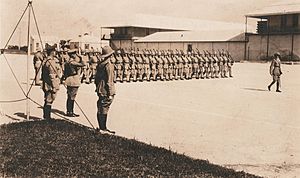
After the First World War, some battalions of the regiment changed roles. In 1936, the 8th (Leeds Rifles) Battalion became an Anti-Aircraft Brigade in the Royal Artillery. This meant they operated guns to shoot down enemy planes.
In 1937, the 6th Battalion became an Anti-Aircraft Battalion in the Royal Engineers. Later, it became a searchlight regiment, using powerful lights to find enemy aircraft at night.
In 1938, the 7th (Leeds Rifles) Battalion became an armoured unit, the 45th (Leeds Rifles) Royal Tank Regiment. This meant they now fought using tanks. Another tank unit, the 51st (Leeds Rifles) Battalion, was formed in 1939.
Second World War: 1939 to 1945
Both the 1st and 2nd battalions of the West Yorks fought in the Far East during the Burma Campaign. They were part of the British Fourteenth Army.
In 1942, the 2/5th Battalion West Yorkshire Regiment also became an armoured unit. They were renamed the 113th Regiment Royal Armoured Corps. Even though they were now tank soldiers, they still wore their West Yorkshire cap badge.
The 51st (Leeds Rifles) Royal Tank Regiment fought bravely in the Italian campaign. They helped the 1st Canadian Infantry Division attack the Hitler Line in May 1944. Because of their courage, the 51st RTR was allowed to wear the Maple Leaf (Canada's symbol) as an extra badge.
After the Wars: 1948 to 1958
In 1948, the 1st and 2nd Battalions joined together. They served in Austria, Egypt, and Malaya. After a period in Northern Ireland, the 1st Battalion took part in the Suez Crisis in 1956. They were then stationed in Dover until the regiment merged in July 1958.
In 1956, the 45th/51st (Leeds Rifles) RTR went back to being an infantry unit. It became the 7th (Leeds Rifles) Bn West Yorkshire Regt. Later, it joined with another unit to form The Leeds Rifles, The Prince of Wales's Own Regiment of Yorkshire.
Regimental Museum
You can learn more about the West Yorkshire Regiment at the York Army Museum. It is located at the Tower Street drill hall in York.
Battle Honours
The regiment earned many battle honours for its bravery in different wars. These include:
- Namur 1695, Tournay, Corunna, India, Java, Waterloo, Sevastopol, New Zealand, Afghanistan 1879–80, Relief of Ladysmith, South Africa 1899–1902.
- From the First World War: Aisne 1914 '18, Armentières 1914, Neuve Chapelle, Loos, Somme 1916 '18, Arras 1917 '18, Ypres 1917 '18, Passchendaele, Cambrai 1917 '18, St. Quentin, Villers Bretonneux, Lys, Amiens, Hindenburg Line, France and Flanders 1914–18, Italy 1917–18, Gallipoli 1915, Egypt 1915–16.
- From the Second World War: North-West Europe 1940, Keren, Abyssinia 1940–41, North Africa 1940–42, Burma 1942–45, Imphal, Meiktila.
- The 7th Battalion (Leeds Rifles) also proudly wore a Maple Leaf badge. This was to remember their brave attack on the Adolf Hitler Line with Canadian soldiers.
Victoria Cross Heroes
Several members of the regiment were awarded the Victoria Cross for their extreme bravery:
- Captain (later Colonel) Conwyn Mansel-Jones, during the Second Boer War.
- Sergeant William Bernard Traynor, during the Second Boer War.
- Private William Boynton Butler, during the First World War.
- Corporal (later Major) Samuel Meekosha, during the First World War.
- Sergeant Albert Mountain, during the First World War.
- Corporal (later Captain) George Sanders, during the First World War.
- Acting Sergeant Hanson Victor Turner, during the Second World War.
Leaders of the Regiment
The regiment had many important leaders, called Colonels of the Regiment, throughout its history. These included:
- Lt-Gen. Sir Edward Hales, 3rd Baronet (1685–1688)
- Lt-Gen. John Tidcomb (1692–1713)
- Maj-Gen. Edward Braddock (1753–1755)
- Gen. The Rt. Hon. Robert Cuninghame, 1st Baron Rossmore (1775–1787)
- Gen. Sir Harry Calvert, 1st Baronet (1806–1826)
- Gen. Sir James Watson (1837–1862)
- Gen. Sir Martin Andrew Dillon (1897–1904)
- Maj-Gen. Sir William Fry (1914–1934)
- F.M. Sir William Joseph Slim, 1st Viscount Slim (1947–1956)



